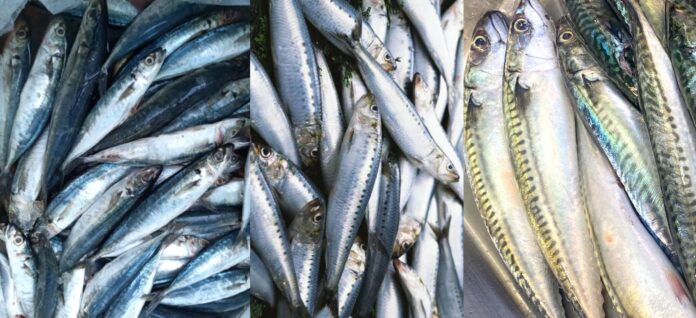-
Under Department of Agriculture Administrative Order No. 01-2022, all sanitary and phytosanitary import clearances covering the importation of 60,000 MT of small pelagic fish must be issued before the lifting of the closed fishing season
-
The DA earlier approved the importation to augment local catch after typhoon Odette damaged the fisheries and aquaculture sector and while the closed fishing season is still in effect
-
Importers must pay P500 for every metric ton of volume awarded under the above program
-
Only importers of good standing may participate in the importation
-
Industry groups and several lawmakers are opposing the importation, saying it would hurt local fishers
Importers will have to pay P500 for every metric ton (MT) of volume awarded to them when they participate in the Department of Agriculture’s (DA) move to import 60,000 MT of frozen small pelagic fish.
The requirement is part of guidelines under DA Administrative Order (AO) No. 01-2022, which implements Fisheries Administrative Order No. 259 in relation to the issuance of sanitary and phytosanitary import clearances (SPSIC) for the Certificate of Necessity to Import (CNI) for 60,000 MT of frozen small pelagic fish for wet markets during the first quarter of 2022.
AO 01-2022 was signed and took effect on January 18, 2022.
DA said the move to import aims to augment the local catch after typhoon Odette damaged the fisheries and aquaculture sector and while the closed fishing season is still in effect in three major fishing grounds (Visayan Sea, Northern Palawan and Basilan-Sulu-Zamboanga).
READ: PH to import 60,000 MT of fish to plug shortage
Under AO 01-2022, all SPSICs under the CNI for 60,000 MT of small pelagic fish should be issued before the closed fishing season is lifted and will automatically expire on March 31, 2022.
The imported frozen small pelagic fish will be immediately disposed of within 20 days upon arrival.
AO 01-2022 said the performance in the disposal, as well as disposition reports, may be one of the considerations in determining qualified importers for the next CNI that may be issued.
Only importers of good standing—those who meet all qualifications under AO 01-2022—may participate in the importation. These qualifications include the following:
- The importer was able to import at least 70% of the total volume issued during the last importation period;
- The importer has no case filed against them by the Bureau of Fisheries and Aquatic Resources (BFAR) for violation of any food safety or importation rules and regulations;
- The importer is willing to sell the imported fish at a price determined after the auction, which should not exceed P90, and the fish should be traded only in any of the Philippine Fisheries Development Authority (PFDA)-designated trading area or PFDA fish ports for effective monitoring of fish disposition;
- The importer is willing to pay P500 for every MT of volume awarded.
Moreover, the importer should directly unload and trade the imported products at the PFDA fish ports or PFDA-designated trading areas. It should also source supply from respectable sources and should not engage in illegal, unreported, and unregulated fishing.
The importer must be able to ship out the imported small pelagic fish species from the port of origin within 20 days from receipt of SPSICs. It should allow BFAR Inspectors, quarantine officers, and law enforcers to inspect and monitor the imported fish stored in the BFAR-registered storage facility, and it must provide data for evaluation of the CNI performance.
The 60,000 MT volume will be apportioned through auction among the registered and qualified importers who have met the requirements under AO 01-2022. Transfer of allocation is not allowed.
After the auction, the importer should immediately apply for SPSIC, and BFAR should immediately process such applications and endorse them to the DA secretary for approval.
All qualified importers should strictly comply with food safety standards provided under the law and relevant regulations.
In an earlier statement, DA Secretary William Dar said the CNI is seen as a means to stem the high prices of fish, hurting swathes of the Filipino population obtaining their protein sources from small pelagic fish such as galunggong (round scad), sardines, and mackerel. Dar said BFAR is projecting a 119,000 MT fish supply deficiency this quarter.
Industry groups Pambansang Lakas ng Kilusang Mamamalakayang Pilipinas (PAMALAKAYA) and Samahang Industriyang Agrikultura (SINAG), as well as several lawmakers are opposing the importation, saying it would hurt local fishers.
“Flooding our local markets with imported fish will pose more harm than good to our struggling fishing industry,” PAMALAKAYA national chairperson Fernando Hicap said.
“This liberalization scheme never addresses the country’s crisis in fisheries production. Rather, it is burden to local fisherfolks whose fishery products are affected by imported fish,” Hicap added.
PAMAKALAYA said the projected supply deficiency is caused by the existing closed fishing season.
“The existing closed fishing season creates an artificial shortage of fish and inflation that detriments fisherfolks and consumers. We maintain that the shortage of fish is artificial, caused by unregulated and unjust declaration of closed fishing season in our productive fishing grounds,” Hicap said.
According to the DA, the closed fishing season is implemented annually to allow fish stocks to replenish and recover in a bid to ensure abundant supply.
SINAG, in a statement, said fish supply is ample despite the onslaught of typhoon Odette.
The National Fisheries and Aquatic Resources Management Council earlier also said the country had enough fish supply.





